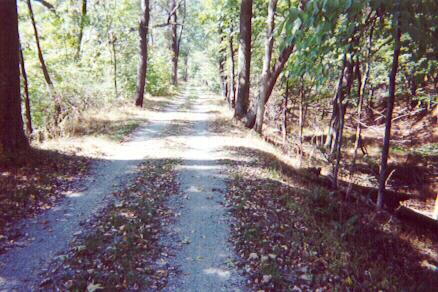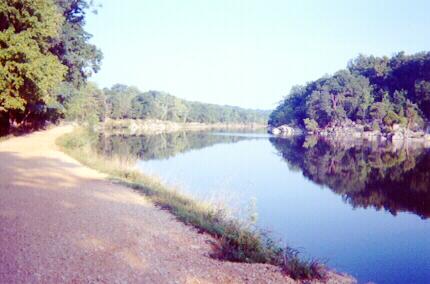My quest to bike the length of the C & O Canal began on August 18, 2002. At that time I thought the full journey would be completed in three segments over the course of a month or two, but inappropriate weather and scheduling complications delayed the second segment until October 6, 2002. No other opportunities were available before winter, so I was frustrated about my unfinished task for 8 months. Finally, all the pieces fell in place for the final third segment attempt on June 29, 2003. This third segment required the most driving since it was furthest from home.
On Saturday afternoon June 28th we drove about 4.5 hours to our motel in Williamsport, MD. After a restless, noisy night with little sleep I arose at 5:00 Sunday morning anxious to begin the trip. Once the car was packed we drove about 40 minutes west along I-70 to Hancock, MD.
 |
| At the start in Hancock, MD. |
The first miles felt great! I was very happy to be under way after so much waiting and anticipation! Pedaling was effortless. I was completely alone. No other bikers appeared along the trail for about 2.5 hours during the first 24 miles!
 |
| An aqueduct during the early miles. |
 |
| I had the shaded trail all to myself. |
 |
| The Potomac River through a rare break in trailside vegetation. |
Speaking of port-a-potties … Fortunately, there are plenty of them along the way at campsites, one about every 4 miles or so. Generally, they are in remarkably good condition. As I exited one of the port-a-potties two older woman bikers happened to come along. One of them wanted to use the port-a-potty and asked me, “How was it?” This seemed hilarious to me! First I told her, “It’s pretty good.” Then I said, “It seems pretty strange to be reviewing a port-a-potty! I rate this one an 8.5 out of 10. When you stop holding your breath, you can actually breathe without having your eyes water. Three and a half stars!”
I reached the halfway point in about 3 hours averaging close to 10 MPH. My shoulders were hardly cramped. My legs felt fine. I passed milepost 154. Only about one more mile remained to the famous Paw Paw tunnel named after the nearby town of Paw Paw, WV. For more than 8 months I had been anticipating this moment with some apprehension. The tunnel is about 0.6 miles long. The C & O biking website warned that the tunnel was “VERY DARK” and recommended bringing a flashlight. I feared the tunnel was so long that neither entrance would be visible near the midpoint, and any flashlight malfunction would plunge me into utter darkness. In spite of the guardrail supposedly present to prevent a “steep drop” to the canal, I worried about falling over the edge into the canal in the darkness. So I brought a flashlight with new batteries and carried this extra weight for the whole trip.
 |
| Approaching the Paw Paw Tunnel. |
 |
| The southern entrance to the Paw Paw Tunnel. |
 |
| View from inside the tunnel looking back toward the distant entrance. |
 |
| Looking back toward the tunnel exit after passing through. |
After the tunnel I continued on happily. Fatigue slowly built, but only a general tiredness and stiffness between my shoulder blades. I felt less tired on this trip than on the previous two.
 |
| A nice view during the final miles. |
 |
| The lock keeper's house I visited. The lock itself is the stone structure to the right. |
 |
| Stubborn mules traveled the full length of the canal. |
 |
| At trail's end in Cumberland, MD. |































